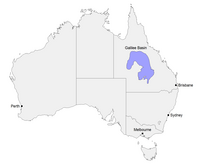
Photo from wikipedia
This multidisciplinary study describes the burial and exhumation history of the frontier Galilee Basin in central Queensland, Australia, with implications for understanding its geohistory and unconventional gas prospectivity. Seismic interpretation,… Click to show full abstract
This multidisciplinary study describes the burial and exhumation history of the frontier Galilee Basin in central Queensland, Australia, with implications for understanding its geohistory and unconventional gas prospectivity. Seismic interpretation, stratigraphic mapping, and an analysis of exhumation through quantifying overcompaction show total subsidence of approximately 2 km (∼6600 ft) from the Carboniferous to the Late Cretaceous, punctuated by two major exhumation events. Triassic exhumation was less than 600 m (<1970 ft), whereas Late Cretaceous exhumation was in the order of 1000 m (3300 ft), increasing eastward to greater than 1600 m (5250 ft). Geohistory reconstructions show that Permian coal measures generated up to 45 m3/t (1590 ft3/t) of gas when modeled temperatures exceeded 100°C (210°F) during maximum burial of 1.5–2 km (4920–6560 ft) in the Late Cretaceous. In the Carboniferous to the mid-Cretaceous, the basin was situated to the west of the Eastern Australian subduction zone, where proto-Pacific oceanic lithosphere was subducted until circa 100 Ma, when subduction ceased. Our study shows that the geohistory of the basin is characterized by rapid subsidence of 50 m/m.y. (165 ft/m.y.) followed by rebound at circa 95 Ma resulting in an uplift and erosion phase. The undersaturation of the coals at present day is explained by this uplift event. Carbon isotopes indicate that the remaining gas (<8 m3/t [<280 ft3/t]) is of mixed biogenic and thermogenic origin. Therefore, dynamic surface topography driven by subduction dynamics and slab breakoff had a profound effect on the subsidence, uplift, and resource potential of the Galilee Basin.
Journal Title: AAPG Bulletin
Year Published: 2018
Link to full text (if available)
Share on Social Media: Sign Up to like & get
recommendations!